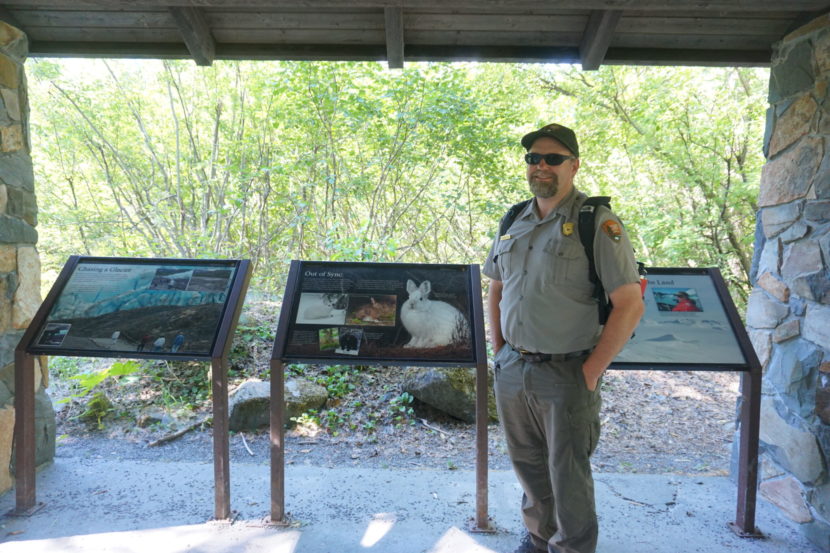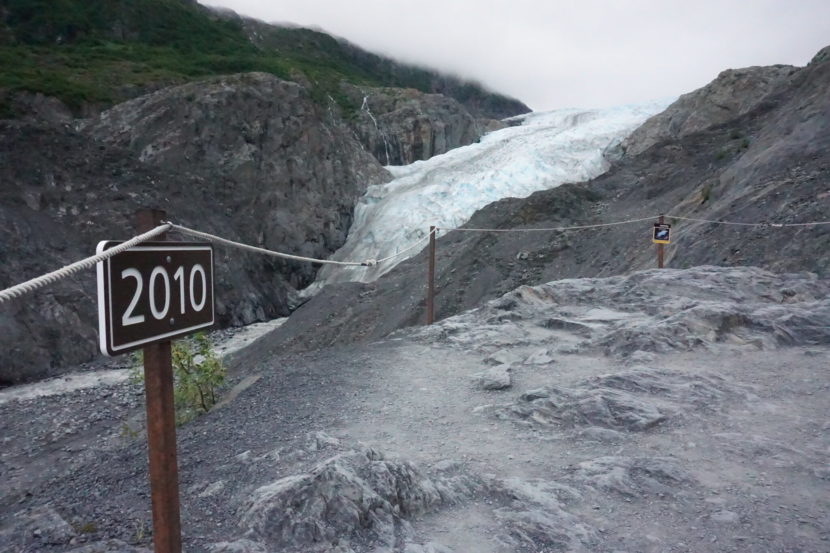
On the route to one of Alaska’s most-viewed glaciers, there is little doubt about the destination. Visitors drive on Exit Glacier Road to get to the Exit Glacier trailhead of the 1-mile Exit Glacier trail that takes them to the face of Exit Glacier in Kenai Fjords National Park.
Now, with the climate continuing to warm, park managers are faced with a question: What will visitors do in that section of the park when rapidly shrinking Exit Glacier finally disappears from view?
“There’s going to be some big changes in how we think about this area,” said Benjamin Pister, leader of the park’s resource management team. “It’s not going to be about Exit Glacier in the future.”
Fister is coordinating a project at Kenai Fjords that is envisioning and planning for visitor services in the decades to come. The Kenai Fjords Frontcountry Management Plan seeks to guide operations to 2040 and perhaps longer.
There is an obvious need for such planning.
As of 2015, Exit Glacier had retreated a little over 1.5 miles in two centuries. The loss is accelerating; from the early 2000s to now, the retreat has been close to half a mile. And. It is not just the terminus that is shriveling; the glacier is becoming narrower, exposing large areas of rock.

What’s happening at Exit Glacier is being repeated across Alaska as warming temperatures hasten glaciers’ retreat. That is forcing managers of some of the state’s most popular tourism and recreation destinations to make changes now and plan for more in the future.
As Exit Glacier is shrinking, visitation to the Exit Glacier area of the park is steadily increasing, from about 120,000 in the summer of 2000 to more than 200,000 last summer, according to Park Service statistics.
The mile-long trail used by throngs of visitors, from elderly cruise ship passengers to young children to President Barack Obama in 2015, has been extended twice and now ends at a steep slope. Further extensions are impossible without some complicated and time-consuming blasting that would probably be futile, Pister said.
“By the time we built a new trail up to the glacier, the glacier won’t be there anymore,” he said.
Similarly, a stone pavilion along the trail that is now hemmed in by alder trees and other greenery. “This was built to have a nice view of the glacier. Obviously, it doesn’t anymore,” said Pister, stopping at the site. It has been repurposed to provide a natural history lesson about ecological changes that happen when glaciers disappear.

The park’s frontcountry management process is just in its early stages. So far, it has attracted some public comment, including suggestions from locals for more visitor amenities in a different site, nearby Paradise Valley, that gets snowmachine use in the winter.
Ultimately, the goal is to ensure that attractions for Kenai Fjords’ growing numbers of visitors do not disappear when Exit Glacier does.
There are some options, Pister said.
“Glaciers do some really amazing things to the landscape when they go away,” he said. Yosemite National Park, for example, is a big glacial valley, and the valley left by Exit Glacier could be something like that, he said. “I prefer to think of it as a new Turnagain Pass,” he said, referring to the mountainous area at the north end of the Kenai Peninsula.
Though Exit Glacier gets much of the attention, ice losses in Kenai Fjords are widespread.


A newly published study of 19 other glaciers in the park – a selection among the approximately three dozen that spill off the 700-square-mile Harding Icefield – found that 14 have lost “substantial area” since the mid-1980s. Between 1984 and 2021, the glaciers in the study showed a cumulative loss of about 16 square miles of ice area, about 57% of that at the terminus, or end, points and 43% along the sides. And the 2021 measurements may be already out of date, given how fast the losses are happening, said the study, by University of Washington and National Park Service scientists and published Aug. 5 in the Journal of Glaciology.
“Most obviously, the Kenai Fjords viewscape is changing dramatically as tidewater glaciers retreat onto land and land-terminating glaciers retreat into the alpine or out of sight around a bend,” said the study, which recommends annual updates. “Our measurements indicate that most of the glaciers in Kenai Fjords National Park are shrinking rapidly, leading to measurable annual landscape change.”

Like Kenai Fjords, other Alaska park or recreation sites with glaciers are undergoing rapid change – and some management adjustments.
At Portage Glacier, a popular Chugach National Forest destination about an hour’s drive south of Anchorage, the visitor center no longer offers views of the glacier face. The center, built at the edge of Portage Lake with big picture windows facing the glacier, opened to the public in 1986; within a decade Portage Glacier had retreated out of sight, grounding on land on the opposite side of the lake. “Of course, the design was so you could see the glacier, and everything was sitting right here,” said Adrienne McGill, the Begich, Boggs Visitor Center’s director.
Now seeing Portage Glacier up close requires a trip across the lake, which many visitors do by motorized tour boat. Exhibits at the visitor center, which typically serves hundreds of people a day during the summer season, place a lot of emphasis on glacial retreat and the landscape changes that follow. Some leaf through the scrapbook of photographs at the front desk that shows Portage Glacier’s face from years past, and some are return visitors who are shocked by the changes, McGill said. “They reminisce a lot when they come here,” she said.
At Mendenhall Glacier in Juneau, a Tongass National Forest site that gets over 600,000 visitors annually, the Forest Service is going through its own process to upgrade facilities for what is expected to be an even bigger crush of tourists in a less-icy future. The situation is not as extreme as at Exit or Portage glaciers, but changes are coming, said Monique Nelson, a land management planner at the Tongass working on the project. “In the next 20 to 40 years, you probably won’t be able to see it from the visitor center,” she said of the glacier.

The Forest Service has a master plan to expand facilities, adding another visitor center closer to the glacier, and to transform footpaths into designated trails to take walkers to the ice edge. The plan also contemplates motorized boat tours, such as that at Portage. Some of that is controversial with Juneau locals, who have expressed concerns about overdevelopment of a well-loved recreational site, Nelson said.
At Denali National Park, where the sole park road is plagued with thaw-induced landslide dangers, most critically at the midpoint, glacial loss at higher elevations is affecting the mountain-climbing season. On Kahiltna Glacier, which is used as base camp for most Denali mountaineering expeditions, conditions are starting to get marginal for ski-equipped planes that ferry climbers on and off the mountain, said Mike Loso, a National Park Service geologist and glacier expert who works out of Wrangell-St. Elias National Park.
Because of melt dangers, in the latter part of the season, plane operations have to shift to a Kahiltna Glacier site about half a mile uphill, Loso said. That is as far as the planes can move, he said; crevasses and rock faces preclude any shifts farther uphill.
At Glacier Bay National Park in Southeast Alaska, 250 years of glacial retreat has been so dramatic that the land is actually rising. Through a phenomenon known as “isostatic rebound,” uncovered land that was previously compacted by heavy glacial ice has now sprung up, expanding the onshore territory.

For Glacier Bay’s visitors, the ice losses are a prime attraction.
Most Glacier Bay visitors come on cruise ships, and those cruise passengers want to see tidewater glaciers calving ice chunks into the sea, Loso said. There are about six or seven tidewater glaciers remaining in the park, but as they crumble and melt, they will “ground themselves out” and no longer extend to marine waters, he said. “The trend overall is clear, and I can say with confidence that there are going to be fewer tidewater glaciers for cruise ship passengers to look at over there,” he said.
That might mean a shift to Wrangell-St. Elias to the west, where Hubbard Glacier, currently the destination for only a few cruise ships, “is still huge and going to be calving ice for a long time,” he said.
Wrangell-St. Elias has its own trail problem linked to glacial retreat. The trail to Root Glacier, like the more heavily trod Exit Glacier trail, has been extended about 0.4 miles. That might seem like a minor distance, but it has made for some tougher travel to the park’s most accessible glacier, Loso said.
“You have to drop further down the hillside and go further up the valley every year to get to the ice,” he said. “In 30 years, what used to be an easy day hike for all of our visitors might be a much more challenging and difficult trip to make.”

There is potentially a side benefit of glacial melt: a big and expanding proglacial lake that didn’t exist 30 year ago at the base of Kennicott Glacier. “It’s a new thing. McCarthy is sort of a lakefront town,” Loso said.
But glacial melt also creates dangers. An ominous trend in all the world’s mountainous and glaciated areas is the increasing risks for landslides and the localized tsunamis they cause as glaciers that buttress mountain slopes shrink. Glacier Bay and Wrangell-St. Elias, with their combination of glacial ice, steep mountainsides, coastlines and locations at latitudes where glacial conditions have become marginal, are considered global hotspots for such slides. At Glacier Bay, there were at least 24 large rockslides or rock avalanches that occurred between 1986 and 2016 that were tied to warming conditions, according to the U.S. Geological Survey. Wrangell-St. Elias in 2015 had North America’s largest non-volcanic landslide on record, a huge slope collapse caused by the combination of glacial retreat and upper-elevation thaw. The resulting tsunami in Taan Fjord that rose as high as 633 feet up the opposite slope, ripping out trees. No injuries or effects on people in Alaska parks, but a similar landslide and tsunami in Greenland in 2017 killed four people.
Continued sweeping changes in Alaska’s glacial landscapes are considered inevitable.

Loso is working on a project to predict the rate of retreat in all of Alaska’s national parks. So far, results show that the outlook over the next few decades is grim for glaciers at parks across Alaska, he said.
“Wrangell-St. Elias is the only park that retains anything close to its glacial coverage,” he said. “Wrangell is the glacier heavyweight.”
Future generations of Alaskans and Alaska visitors present at the end of the century will likely catch only faraway glimpses of the glacial ice that is currently a fixture in the Alaska scenery, he said.
“When you look at the year 2100, the stuff we’re talking about, it’s going to be distant,” he said. “It’s going to be hard for the public to see glaciers anywhere.”



